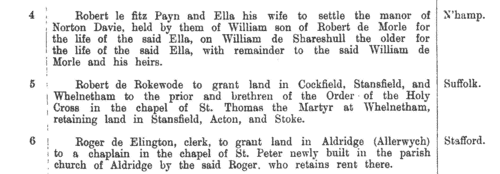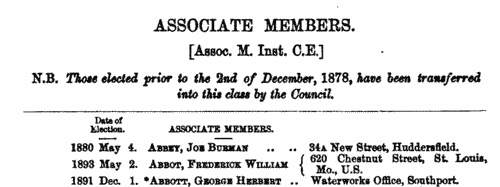Whithard Surname Ancestry ResultsOur indexes 1000-1999 include entries for the spelling 'whithard'. In the period you have requested, we have the following 4 records (displaying 1 to 4): Buy all | | | Get all 4 records to view, to save and print for £20.00 |
These sample scans are from the original record. You will get scans of the full pages or articles where the surname you searched for has been found. Your web browser may prevent the sample windows from opening; in this case please change your browser settings to allow pop-up windows from this site. Grantees of offices, commissions and pardons
(1413-1416)
The Patent Rolls are the Chancery enrolments of royal letters patent. Those for the 1st, 2nd and 3rd years of the reign of king Henry V (21 March 1413 to 20 March 1416) were edited for the Public Record Office by R. C. Fowler, and published in 1910. The main contents are royal commissions and grants; ratifications of ecclesiastical estates; writs of aid to royal servants and purveyors; and pardons. The commissions of the peace issued for the English towns and counties and entered on the rolls, being largely repetitive, have been consolidated in a single appendix.WHITHARD. Cost: £2.00.  | Sample scan, click to enlarge

| Landowners and tenants in Sussex
(1345-1485)
Inquisitions ad quod damnum were held by the appropriate sheriff or escheator (or other officer in whose bailiwick the matter in question might lie) to investigate cases in which the royal or public interest might be damaged by proposed alienation or settlement of land (especially alienation to religious uses, into mortmain). The key findings from these inquisitions were as to the tenure of the land and the service due from it; its yearly value; the lands remaining to the grantor, and whether they sufficed to discharge all duties and customs due from him; and whether he can still be put upon juries, assizes and recognitions, so that the country be not burdened by his withdrawal from them. Generally speaking, this process had the makings of a system of licensing such alienations, and raising money in proportion to the valuations. Equally, there are many items that deal with subjects such as the closing of public roads, the felling or inclosing of woods, or the proposed grant of liberties or immunities. A calendar of these inquisitions from the 19th year of the reign of king Edward III to the 2nd year of Richard III was prepared by the Public Record Office and published in 1906. We have now indexed this calendar by surname and county. Most of the individuals appearing in the calendar are either pious individuals seeking to make grants to religious bodies for the sake of their souls; or landowners securing the disposition and settling of their real estate. But some other names do appear - tenants, trustees, chaplains and clerks.WHITHARD. Cost: £6.00.  | Sample scan, click to enlarge

| Long-stay Paupers in Workhouses: St Leonard, Shoreditch, Parish
(1861)
This comprehensive return by the Poor Law Board for England and Wales in July 1861 revealed that of the 67,800 paupers aged 16 or over, exclusive of vagrants, then in the Board's workhouses, 14,216 (6,569 men, 7,647 women) had been inmates for a continuous period of five years and upwards. The return lists all these long-stay inmates from each of the 626 workhouses that had been existence for five years and more, giving full name; the amount of time that each had been in the workhouse (years and months); the reason assigned why the pauper in each case was unable to sustain himself or herself; and whether or not the pauper had been brought up in a district or workhouse school (very few had). The commonest reasons given for this long stay in the workhouse were: old age and infirm (3,331); infirm (2,565); idiot (1,565); weak mind (1,026); imbecile (997); and illness (493). WHITHARD. Cost: £6.00.  | Sample scan, click to enlarge

| Associate Members of the Institution of Civil Engineers
(1904)
The Institution of Civil Engineers was established 2 January 1818, and incorporated by royal charter 3 June 1828. The annual report lists the names and addresses (throughout the world) of the four classes of member - members (M. Inst. C. E.), associate members (Assoc. M. Inst. C. E.), associates (Assoc. Inst. C. E.), students (Stud. Inst. C. E.) - with the dates of admission. This is the index to the Associate Members. The symbols at the left of each page are * for Former Students, + for contributors of papers published in the Minutes of Proceedings, or of an Engineering Conference Note; F for a deliverer of a James Forrest Lecture; L for a deliverer of one of the Special Series of Lectures; and various letters for recipients of certain medals and prizes - B, Bayliss Prize; C, Crampton Prize; f, James Forrest Medal; H, Howard Quinquennial Prize; J, Joule Medal; M, Miller Scholarship; m, Miller Prize; italic m, Manby Premium; S, George Stephenson Medal or Prize; T, Telford Premium; t, Telford Premium; italic t, Trevithick Premium; and W, Watt Medal. Those elected prior to 2 December 1878 had been transferred into this class by the Council.WHITHARD. Cost: £6.00.  | Sample scan, click to enlarge

|
Research your ancestry, family history, genealogy and one-name study by direct access to original records and archives indexed by surname.
|






